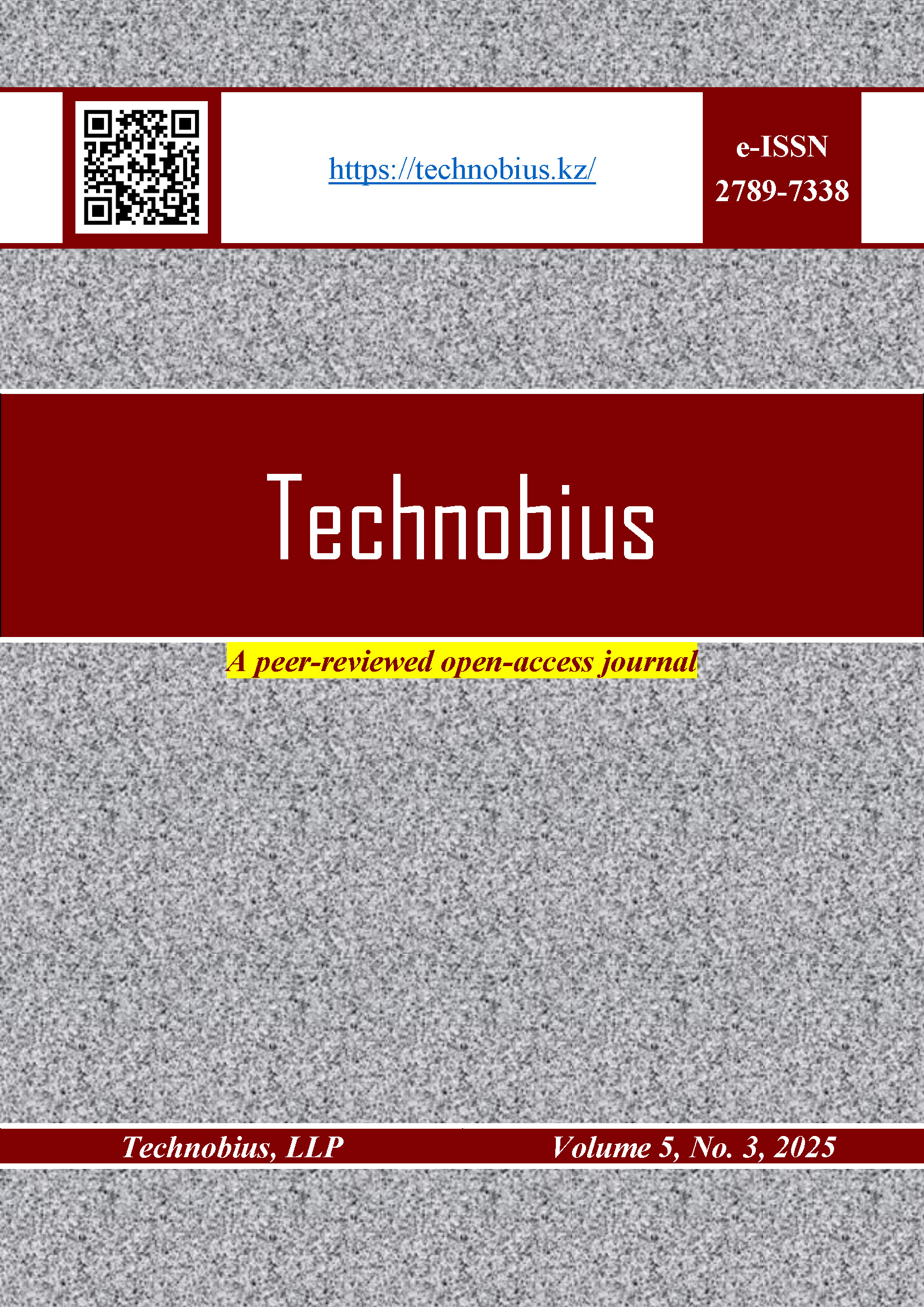Eco-efficient composite cements and arbolite using burnt clay shale from the Mynaral deposit
DOI:
https://doi.org/10.54355/tbus/5.3.2025.0087Keywords:
arbolite, rice husks, strength, binders, composite cement, active mineral additives, clay shaleAbstract
This study investigates the potential of burnt clay shale (BCS) from the Mynaral deposit (Zhambyl region, Kazakhstan) as an active mineral additive in composite cements and arbolite. Thermal and X-ray diffraction analyses revealed progressive dehydration, decarbonation, and decomposition of kaolinite, chlorite, and calcite, with optimal activation at 900 °C. Pozzolanic activity tests confirmed maximum reactivity at this temperature. Mechanical testing showed that 10–15% BCS increased cement strength up to 51 MPa, while higher dosages reduced performance. Arbolite samples with ash-and-slag binders and controlled alkaline additives demonstrated superior density and strength, supported by SEM evidence of dense crystalline microstructures and strong binder–filler adhesion. The findings highlight BCS as an effective, eco-friendly component reducing clinker consumption and CO2 emissions.
Downloads
Metrics
References
M. Dlimi, R. Agounoun, I. Kadiri, R. Saadani, and M. Rahmoune, “Thermal performance assessment of double hollow brick walls filled with hemp concrete insulation material through computational fluid dynamics analysis and dynamic thermal simulations,” e-Prime - Advances in Electrical Engineering, Electronics and Energy, vol. 3, p. 100124, Mar. 2023, doi: 10.1016/j.prime.2023.100124. DOI: https://doi.org/10.1016/j.prime.2023.100124
B. Martínez, V. Mendizabal, M. B. Roncero, E. Bernat-Maso, and L. Gil, “Towards sustainable building solutions: Development of hemp shiv-based green insulation material,” Constr Build Mater, vol. 414, p. 134987, Feb. 2024, doi: 10.1016/j.conbuildmat.2024.134987. DOI: https://doi.org/10.1016/j.conbuildmat.2024.134987
K. Imanaliyev, B. Amiraliyev, K. Akmalaiuly, E. Kuldeyev, E. Yunusaliyev, and Z. Aymenov, “Research of technological parameters for producing thermal insulating arbolite based on developed slag alkali binders,” Technobius, vol. 4, no. 3, p. 0065, Sep. 2024, doi: 10.54355/tbus/4.3.2024.0065. DOI: https://doi.org/10.54355/tbus/4.3.2024.0065
X. Ding, J. Yu, J. Lin, Z. Chen, and J. Li, “Experimental investigations of prefabricated lightweight self-insulating foamed concrete wall panels,” Structures, vol. 61, p. 106001, Mar. 2024, doi: 10.1016/j.istruc.2024.106001. DOI: https://doi.org/10.1016/j.istruc.2024.106001
I. E. Kazimagomedov, L. V Trykoz, F. I. Kazimagomedov, and A. V Rachkovskiy, “Study of the forming processes of the arbolite structure during the chemical activation of flax shove,” IOP Conf Ser Mater Sci Eng, vol. 708, no. 1, p. 012086, Dec. 2019, doi: 10.1088/1757-899X/708/1/012086. DOI: https://doi.org/10.1088/1757-899X/708/1/012086
N. N. Zhanikulov et al., “Receiving Portland Cement from Technogenic Raw Materials of South Kazakhstan,” Eurasian Chemico-Technological Journal, vol. 21, no. 4, pp. 333–340, Dec. 2019, doi: 10.18321/ectj890. DOI: https://doi.org/10.18321/ectj890
B. Isakulov, A. Issakulov, and A. Dąbska, “Structure Formation and Curing Stage of Arbolite–Concrete Composites Based on Iron-Sulfur Binders,” Infrastructures (Basel), vol. 10, no. 7, p. 179, Jul. 2025, doi: 10.3390/infrastructures10070179. DOI: https://doi.org/10.3390/infrastructures10070179
B. Amiraliyev et al., “Heat Treatment of Clay Shales and Their Utilization as Active Mineral Additives for the Production of Composite Cements,” Journal of Composites Science, vol. 9, no. 6, p. 269, May 2025, doi: 10.3390/jcs9060269. DOI: https://doi.org/10.3390/jcs9060269
ISO 12677:2011 Chemical analysis of refractory products by X-ray fluorescence (XRF) — Fused cast-bead method. 2011, p. 75.
ISO 11357-1:2023 Plastics — Differential scanning calorimetry (DSC). 2023, p. 34.
D. Alderton, “X-Ray Diffraction (XRD),” in Encyclopedia of Geology, Elsevier, 2021, pp. 520–531. doi: 10.1016/B978-0-08-102908-4.00178-8. DOI: https://doi.org/10.1016/B978-0-08-102908-4.00178-8
I. V. R. Ramanujam, K. R. Reddy, and N. V. Ramana, “Evaluation of Pozzolanic activity and lime reactivity of fly ash, GGBS, mica powder and pumice as binders,” E3S Web of Conferences, vol. 529, p. 01008, May 2024, doi: 10.1051/e3sconf/202452901008. DOI: https://doi.org/10.1051/e3sconf/202452901008
H. Wang, X. Liu, and Z. Zhang, “Pozzolanic activity evaluation methods of solid waste: A review,” J Clean Prod, vol. 402, p. 136783, May 2023, doi: 10.1016/j.jclepro.2023.136783. DOI: https://doi.org/10.1016/j.jclepro.2023.136783
GOST 310.4-81 Cements. Methods of bending and compression strength determination. 1981, p. 11.
GOST 30744-2001 Methods of testing with using polyfraction standard sand. 2001, p. 36.
ASTM C188-17 Test Method for Density of Hydraulic Cement. ASTM International, 2017, p. 3. doi: 10.1520/C0188-17. DOI: https://doi.org/10.1520/C0188-17
GOST 10180-2012. Concrete. Methods for Determining Strength Using Control Specimens. Moscow, Russia, 2018, p. 36.
ISO/TS 21383:2021 Microbeam analysis — Scanning electron microscopy — Qualification of the scanning electron microscope for quantitative measurements. 2021, p. 59.
E. Güneyisi, M. Gesoğlu, Özturan T., and K. Mermerdaş, “Comparing Pozzolanic Activity of Metakaolin and Calcined Kaolin, and Their Effects on Strength of Concrete,” in 10th International Congress on Advances in Civil Engineering (ACE 2012), Ankara, Turkey : Middle East Technical University, 2012, pp. 1–10.
A. Tironi, M. A. Trezza, A. N. Scian, and E. F. Irassar, “Assessment of pozzolanic activity of different calcined clays,” Cem Concr Compos, vol. 37, no. 1, 2013, doi: 10.1016/j.cemconcomp.2013.01.002. DOI: https://doi.org/10.1016/j.cemconcomp.2013.01.002
J. Ambroise, M. Murat, and J. Péra, “Hydration reaction and hardening of calcined clays and related minerals V. Extension of the research and general conclusions,” Cem Concr Res, vol. 15, no. 2, 1985, doi: 10.1016/0008-8846(85)90037-7. DOI: https://doi.org/10.1016/0008-8846(85)90037-7
R. Walker and S. Pavía, “Physical properties and reactivity of pozzolans, and their influence on the properties of lime-pozzolan pastes,” Materials and Structures/Materiaux et Constructions, vol. 44, no. 6, 2011, doi: 10.1617/s11527-010-9689-2. DOI: https://doi.org/10.1617/s11527-010-9689-2
Published
How to Cite
License
Copyright (c) 2025 Baurzhan Amiraliyev, Kuanysh Imanaliyev, Zhambul Aymenov, Erzhan Kuldeyev, Bakhrom Tulaganov

This work is licensed under a Creative Commons Attribution-NonCommercial 4.0 International License.
Funding data
-
Ministry of Education and Science of the Republic of Kazakhstan
Grant numbers BR21882292








